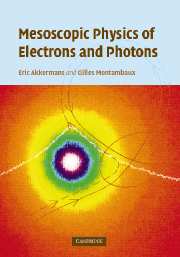Book contents
- Frontmatter
- Contents
- Preface
- How to use this book
- 1 Introduction: mesoscopic physics
- 2 Wave equations in random media
- 3 Perturbation theory
- 4 Probability of quantum diffusion
- 5 Properties of the diffusion equation
- 6 Dephasing
- 7 Electronic transport
- 8 Coherent backscattering of light
- 9 Diffusing wave spectroscopy
- 10 Spectral properties of disordered metals
- 11 Universal conductance fluctuations
- 12 Correlations of speckle patterns
- 13 Interactions and diffusion
- 14 Orbital magnetism and persistent currents
- 15 Formulary
- References
- Index
1 - Introduction: mesoscopic physics
Published online by Cambridge University Press: 06 January 2010
- Frontmatter
- Contents
- Preface
- How to use this book
- 1 Introduction: mesoscopic physics
- 2 Wave equations in random media
- 3 Perturbation theory
- 4 Probability of quantum diffusion
- 5 Properties of the diffusion equation
- 6 Dephasing
- 7 Electronic transport
- 8 Coherent backscattering of light
- 9 Diffusing wave spectroscopy
- 10 Spectral properties of disordered metals
- 11 Universal conductance fluctuations
- 12 Correlations of speckle patterns
- 13 Interactions and diffusion
- 14 Orbital magnetism and persistent currents
- 15 Formulary
- References
- Index
Summary
Interference and disorder
Wave propagation in a random medium is a phenomenon common to many areas of physics. There has been a recent resurgence of interest following the discovery, in both optics and quantum mechanics, of surprising coherent effects in a regime in which disorder was thought to be sufficiently strong to eliminate a priori all interference effects.
To understand the origin of these coherent effects, it may be useful to recall some general facts about interference. Although quite spectacular in quantum mechanics, their description is more intuitive in the context of physical optics. For this reason, we begin with a discussion of interference effects in optics.
Consider a monochromatic wave scattered by an obstacle of some given geometry, e.g., a circular aperture. Figure 1.1 shows the diffraction pattern on a screen placed infinitely far from the obstacle. It exhibits a set of concentric rings, alternately bright and dark, resulting from constructive or destructive interference. According to Huygens' principle, the intensity at a point on the screen may be described by replacing the aperture by an ensemble of virtual coherent point sources and considering the difference in optical paths associated with these sources. In this way, it is possible to associate each interference ring with an integer (the equivalent of a quantum number in quantum mechanics).
Let us consider the robustness of this diffraction pattern. If we illuminate the obstacle by an incoherent source for which the length of the emitted wave trains is sufficiently short that the different virtual sources are out of phase, then the interference pattern on the screen will disappear and the screen will be uniformly illuminated.
- Type
- Chapter
- Information
- Mesoscopic Physics of Electrons and Photons , pp. 1 - 30Publisher: Cambridge University PressPrint publication year: 2007



